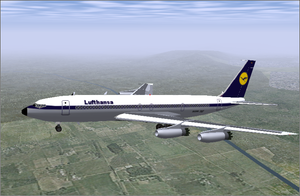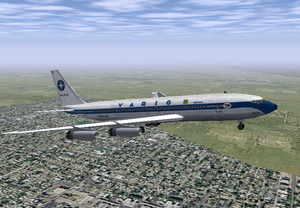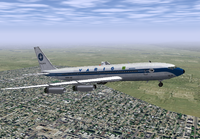Pt/Boeing 707-400
| Prestes hangar | ||
|---|---|---|
 Lufthanse 707-400 | ||
 The VARIG 707-400 PAX | ||
| Tipo | Airliner | |
| Configuração | Low wing aircraft | |
| Propulsão | Quadjet (Jet aircraft, Four-engine aircraft) | |
| Fabricante | Boeing | |
| Author(s) |
| |
| FDM | JSBSim | |
| --aircraft= | 707-400 | |
| Situação | Alpha | |
| Desenvolvimento | ||
| Website |
| |
| Licença | Unknown | |
| ||
|
| ||
O Boeing 707 foi a primeira aeronave a jato, sem finalidade militar, a ser comercializada com sucesso. A sua introdução marca a chama Era do Jato. Devido ao seu sucesso, consolidou a Boeing como o maior fabricante de aeronaves a servir companhias aéreas no mundo. O nome do protótipo do 707 é chama Dash80.
Desenvolvimento
- The initial standard model was the 707-120 with JT3C engines. Qantas ordered a shorter body version called the 707-138, which was a -120 that had six fuselage frames removed, three in front of the wings, three aft. The frames in the 707 were each 20 inches (500 mm) long, so this resulted in a net shortening of 10 ft (3 m) to 134 ft, 6 inches (41 m). Because the maximum takeoff weight remained the same 257,000 lbs (116 Tonne) as the -120, the 138 was able to fly the longer routes that Qantas needed.
- Braniff ordered the higher-thrust version with Pratt & Whitney JT4A engines, the 707-220.
- The final major derivative was the 707-320 which featured an extended-span wing and JT4A engines.
- The 707-420 was the same as the -320 but with Rolls-Royce Conway turbofan engines. British certification requirements relating to engine-out go-arounds also forced Boeing to increase the height of the tail fin on all 707 variants, as well as add a ventral fin, which was retrofitted on earlier -120 and -220 aircraft. These modifications also aided in the mitigation of dutch roll by providing more yaw stability.
A Série -400
A série -400 foi introduzida especificamente para atender um pedido da BOAC, ou seja, uma versão do 707 equipados com turbofans Rols-Royce Conway 508. Assim que iniciado o programa, a Lufthansa foi a primeira companhia aérea a realizar pedido e a Air India a primeira a receber um 400 em 18 de Fevereiro de 1960.
4 x Rolls Royce Conway (17150 lbf) turbofan engines Rolls-Royce Conway 508
O 707-400 no Brasil
A Varig recebeu, a partir de 1960, 2 aeronaves Boeing 707-441, o PP-VJA e o PP-VJB. O PP-VJB acidentou-se em Lima, no Peru, em 1962, e a Varig o substituiu por outro 707-441, o PP-VJJ. Os 707 da Varig faziam SNME além da linha para NY, que aliás, no começo tinha escala (ou mesmo início) em BSB, os 707-400 tb operavam a linha para LAX. Em 18 de novembro 1961 foi iniciada, também com o 707, a linha Rio de Janeiro - Los Angeles com escalas em Lima, Bogotá e México. Quando os 707 chegaram, o Galeão estava em obras para alongamento da pista. Por isso, os 707 faziam Brasilia, N.York,Brasilia. De Brasilia para o Galeão voavam os Caravelles. Quanto ao acidente em Lima, foi após a compra da Real, quando a Varig passou a voar para Los Angeles via Lima, extendendo depois até Tokio, após a chegada dos 320C. Recém inaugurada Capital do Brasil non stop para a Capital do Mundo via Boeing 707 Intercontinental, chique para a época!
Ligações Externas
- A família Boeing 707 na Boeing.com
- Guia detalhado de todas variantes do 707/720 na airlinercafe.com
- Página do Boeing 707 na Airliners.net
Referência
| |||||||||||
